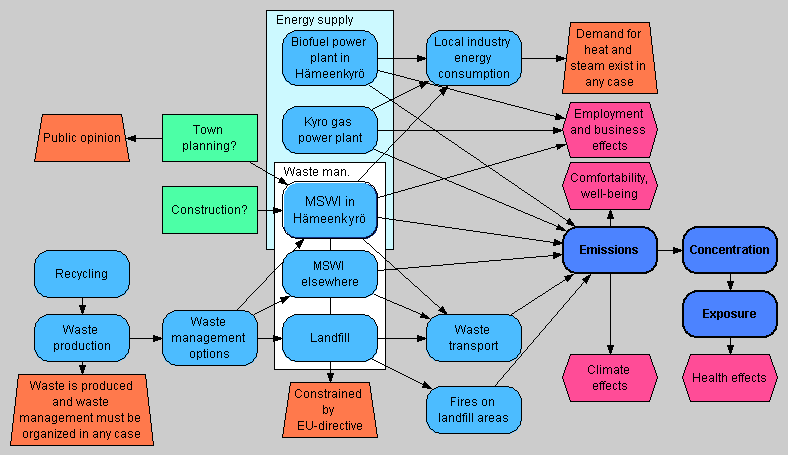Risk assessment on Hämeenkyrö municipal solid waste incinerator: Difference between revisions
Jump to navigation
Jump to search
| Line 189: | Line 189: | ||
}} | }} | ||
Marjo | Marjo | ||
| Line 195: | Line 194: | ||
|Name = | |Name = | ||
|Focus = Baseline dioxin exposure in Hämeenkyrö inhabitants | |Focus = Baseline dioxin exposure in Hämeenkyrö inhabitants | ||
|Scope = | |Scope = The daily intake and the adipose tissue concentration of polychlorinated | ||
|Description = Polychlorinated dibenzo-p-dioxins and dibenzofurans (PCDD/Fs, "dioxins") are ubiquitously present, stable and persistent environmental contaminants. They are fat soluble and thus tend to bioaccumulate in tissue lipid and in the food chain. | dibenzo-p-dioxins, dibenzofurans (PCDD/Fs) and biphenyls (PCBs)in Hämeenkyrö population | ||
|Inputs = | |Description = Polychlorinated dibenzo-p-dioxins and dibenzofurans (PCDD/Fs, "dioxins") are | ||
ubiquitously present, stable and persistent environmental contaminants. They are fat soluble | |||
and thus tend to bioaccumulate in tissue lipid and in the food chain. More than 90 % of the | |||
average human intake of dioxins originates from food, especially food of animal origin. In | |||
Finland the main source is fish, whose contribution is 72-94 % of the total PCDD/F intake | |||
via food. | |||
Here we will use the daily PCDD/F intake estimated for the Finnish population in average as | |||
a starting point. In addition, the other variable in this model, "Dioxin emissions in | |||
Hämeenkyrö", may affect the estimate of baseline dioxin exposure in Hämeenkyrö.For the | |||
adipose tissue PCDD/f concentration the value estimated for the general population living in | |||
Finnish inland is used. Some subgroups within society, such as nursing babies and people | |||
consuming lot of fish may be more highly exposed to dioxins. | |||
PCBs, another group of persistent environmental contaminants, were included as they behave | |||
similarly in the food chain and have partly similar health effects as dioxins. | |||
|Inputs = Dioxin emissions in Hämeenkyrö | |||
|Index = | |Index = | ||
|Definition = | |Definition = | ||
|Unit = | |Unit = 1) Adipose tissue concentration: WHO-TEQ pg/g fat | ||
2) Daily intake: WHO-TEQ pg/kg body weight | |||
|Result = | |Result = Average daily intake of PCDD/Fs 0.79 pg/kg bw | ||
|References = | Average daily intake of PCBs 0.74 pg/kg bw | ||
Average adipose tissue PCDD/F concentration 26.4 pg/g | |||
Average adipose tissue PCB concentration 18.1 pg/g | |||
Note: During the nursing period, the PCDD/F intake of a child can be 1-2 orders of magnitude | |||
higher than that of an adult. | |||
|References = Holtta P, Kiviranta H, Leppaniemi A, Vartiainen T, Lukinmaa PL, Alaluusua S. | |||
Developmental dental defects in children who reside by a river polluted by dioxins and furans. Arch Environ Health. 2001 Nov-Dec;56(6):522-8. | |||
Kiviranta H, Ovaskainen ML, Vartiainen T. Market basket study on dietary intake of PCDD/Fs, | |||
PCBs, and PBDEs in Finland. Environ Int. 2004 Sep;30(7):923-32. | |||
Kiviranta H, Tuomisto JT, Tuomisto J, Tukiainen E, Vartiainen T. Polychlorinated | |||
dibenzo-p-dioxins, dibenzofurans, and biphenyls in the general population in Finland. | |||
Chemosphere. 2005 Aug;60(7):854-69. | |||
Tuomisto et al. 1999. Synopsis on dioxins and PCBs. Publications of the National Public | |||
Health Institute B17/1999. | |||
}} | }} | ||
Revision as of 14:30, 21 September 2006
Risk assessment on Hämeenkyrö municipal solid waste incinerator contains a structured risk assessment of a plan to build a MSWI in Hämeenkyrö. There will be a public vote related to a city planning decision: whether the municipality should plan an area for the plant or not. The vote will be held in November 19, 2006.
Objective
RA of Hämeenkyrö MSWI
Empty variable template
General variables
Optimizing rules
- Precautionary principle (disagreement)
- PP based on expected value, general
- PP based on worst-case or another 'conservative' scenario, general
- PP applied to emissions of municipal solid wasti incinerator (MSWI) in Hämeenkyrö
- Intake fraction (disambiguation)
- iF based on measured concentration fields
- iF based on exposure monitoring
- iF based on shortcuts
Fine particle variables
PM2.5 emissions in Hämeenkyrö
Päivi
PM2.5 emissions in Hämeenkyrö
PM2.5 emissions from MSWI, biofuel plant, and natural gas plant in Hämeenkyrö
Tommi
Baseline PM2.5 exposure in Hämeenkyrö
Anne K
PM2.5 exposure due to MSWI in Hämeenkyrö
Terhi Y
PM2.5 exposure-response function on population level
Sari
Dioxin variables
Dioxin emissions in Hämeenkyrö
Virpi
Marjo
Dioxin exposure due to MSWI in Hämeenkyrö
Martin
Dioxin exposure-response function on population level
Sanna
Responses of dioxin exposure on human health at the population level
Indicator variables
- Decisions related to Hämeenkyrö case
- Possible indicators (optimising variables) in Hämeenkyrö
Well-being of the population (smells, comfort, noise)
Kari Auri
Effects on economy (esp. gas energy plant)
Juha
Effects on economy
Transportation costs of waste
Anne
Health effects of dioxins and PM2.5
Anu T
Health effects
Miscellaneous variables
- Secondary effects on waste separation, recycling etc.)
Municipal solid waste production in Häme
Pasi K
Municipal solid waste production in Häme
Existing MSWI plants and current plans in southern Finland
Marjaleena
Background of waste production and its relations to EU directive
Eva
